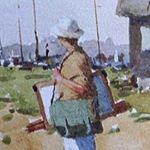
Home Store Online Workshops Videos Appearences Gallery Painting Courses Books and Articles Artist Resources Demo Charges Exhibitions About Contact
Instagram Youtube
RESOURCES FOR ARTISTS - STUDIO NOTES
- Don't copy Nature. You are not recording (cameras do that better). You are making a painting. Painting is a trick. Use paint to create an illusion of what you see. Select and simplify. Recognise the limitations of the medium you are using and at the same time make the most of the medium's characteristics.
- Plan your picture. Make sure the main elements are positioned where you want them in relation to the picture boundaries. Draw slowly to ensure accuracy. Look at the negative spaces. Keep brush/pencil on the paper. This helps maintain accuracy, as new forms are added in relation to what has already been drawn.
- Once the planning/drawing session is complete, finish the picture. Go for the end straight away. To achieve freshness and spontaneity paint each area once. That is aim to get each passage right straight away. Don't correct as you go along. Wait until the end when it is easier to assess the impact of passages which have not gone according to plan. Adopt a workman like approach to painting.
- Watch out for the tendency to focus only on the last thing you painted and miss the whole. Don't make any rash decisions which result in a painting covered with second thoughts.
- Squint to see tone and boundaries/edges. Paint shapes not things. Look out for shapes of similar tone that can be linked, such as shade and cast shadow.
- Open your eyes to see colour. But don't just copy. Use colours that improve your picture. Paint with credible but attractive colour.
- Keep detail, tonal contrast, hard edges and bright colour in the sunlit areas. Dark tones, intense colour and sharp edges come forward. Light toned areas, soft, fuzzy, broken edges and greyed colour go back. Lines and hard boundaries attract the viewer's attention.
- Concentrate on accurate drawing and tone. Use a variety of hard and soft edges to create the illusion of form. Choose an appropriate paint texture to help convey your subject matter.
- Remember: Drawing; Tone; Edges; Colour; Texture. Shapes (drawing), tone and edges must be seen objectively. Tonal value and the sharpness of edges must be assessed relative to other tones and edges - by squinting. Selection and simplification is subjective. Colour and texture are personal. Exploit the opportunity to be creative. Choose colours that look good in your painting. Don't be a slave to "facts".
- Artistic licence means you have the right and the freedom to take liberties with reality for the sake of your painting - often, paradoxically, to convey the truth as you see it.
- There is only one right way to paint; it is your way. And this "right way" is the method that gives you the result you want.
- Learning to paint is learning how to communicate visually using paint and understanding the impact that design/composition, tone, colour, brush stroke edges and texture can make.
- An experienced painter can communicate visually in paint.
- An experienced painter can make the painterly mark/brush stroke they intended to make. They are fluent in (visual) language.
- Instead of trying to be creative, develop a point of view - have an opinion that you can express visually in paint.
- Remember: when painting in watercolour, the paint you see on your palette will look different when it dries on the paper. All watercolours dry lighter and lose some of their colour intensity. Allow for this.
- Pay attention to the consistency of your paint; that is, the paint to water ratio. Develop good painting habits: rinse brush in water, shake/dab the brush, pick up paint and deliver to the paper. Avoid taking water to the picture.
- Avoid adding thoughtless detail and paint strokes. Less is more.
- Ask yourself: is there anything in the painting which attracts attention/catches the eye which didn't when you looked at the subject. This will usually be caused by: too much detail, too greater tonal contrast, too intense colour or the separation edge is too sharp.
- When you get near completing your painting avoid looking for things to add. Let your painting dictate what it needs. Leave some work for the viewer otherwise they will get bored. Rather than over finish, just stop painting.
- Relax and enjoy painting. Don't try too hard. Make you picture look interesting by the way you have painted it and by revealing what you have noticed.
